For me, most of the joy when it comes to specialty home video companies putting out older films is when they start to dig into the lesser-known output of major figures. With the Universal Horror Collection: Volume One, Scream Factory has brought surprisingly great looking restorations to four collaborations between Boris Karloff and Bela Lugosi that, while far from obscure, are usually not the first films mentioned when these horror icons are brought up.
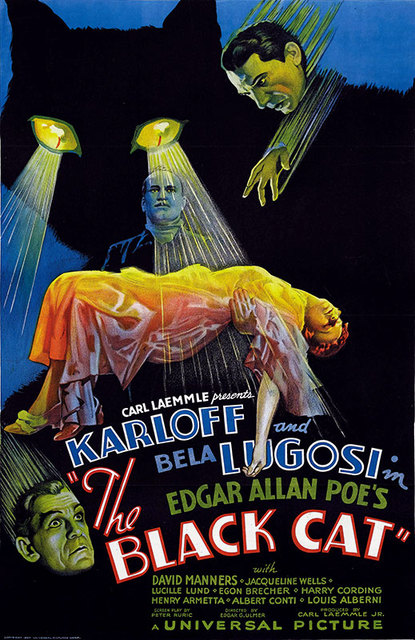
Claiming to be “suggested by” Edgar Allan Poe’s short story of the same name, 1934’s THE BLACK CAT is the undisputed jewel of this collection. Directed by low-budget master Edgar G. Ulmer, it is probably the finest collaboration between Karloff and Lugosi, finding the two stars on equal footing in a tale of psychological torture between two former military comrades whose loyalties split into an ugly feud with each other.
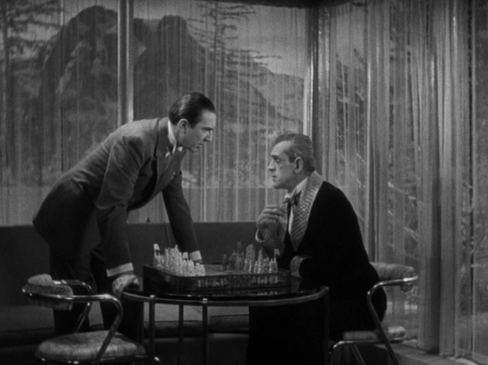
While both men are mad, and Karloff is an effective presence as the Devil-worshipping architect Poelzig–the more truly menacing of the two—Lugosi (not very far removed from his star-making turn as Count Dracula) turns in possibly the best performance of his career as the more sympathetic Dr. Werdegast, a psychologist broken by his time in a prisoner of war camp and the loss of his wife and daughter to Poelzig. Caught between the two madmen is the usual loving, “normal” couple (Julie Bishop, David Manners) that this formula requires. At least in the hands of Ulmer, the couple are portrayed more like actual people with decent senses of humor, a physical relationship that pushes back against the early days of the Hays Code, and the good sense of when to get the hell away (or at least try) from the perverse game of psychological one-upsmanship that Werdegast and Poelzig are engaged in.
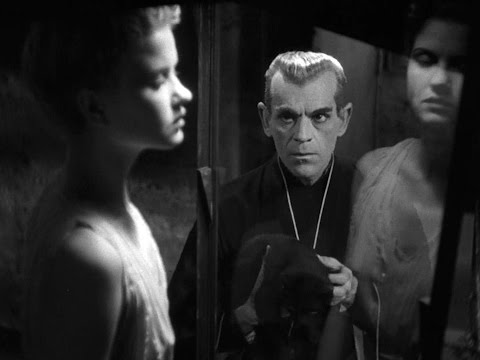
Ulmer keeps the action moving at a breakneck pace (the entire film takes place across roughly 24 hours with a runtime of only 65 minutes) with tight plotting, a strange atmosphere provided by Poelzig’s ultra-modern, yet sinister home and almost nonstop dramatic classical pieces by Liszt, Tchaikovsky, and Beethoven. The grudge match between Werdegast and Poelzig goes to some upsetting, relatively grisly places (once again, thank the movie gods for filmmakers that largely thumbed their noses at the Hays Code before the MPPDA cracked down) and Karloff and Lugosi really are near the tops of their games. THE BLACK CAT is aces all around.
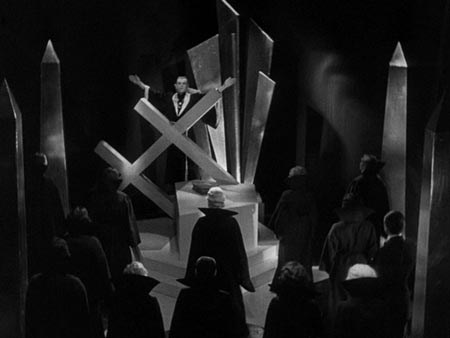
The second film in this set is 1935’s THE RAVEN. Like THE BLACK CAT, it bears little resemblance to the work it takes its title from, but at least this time Poe’s poetry is quoted in a few scenes and his famous torture centerpiece from The Pit and the Pendulum plays a key part. Even better, this is the only film in the set that can truly be called a star vehicle for Lugosi (THE BLACK CAT features the better performance, but here he is the definite lead) and he delivers a wonderfully hammy, unhinged performance.
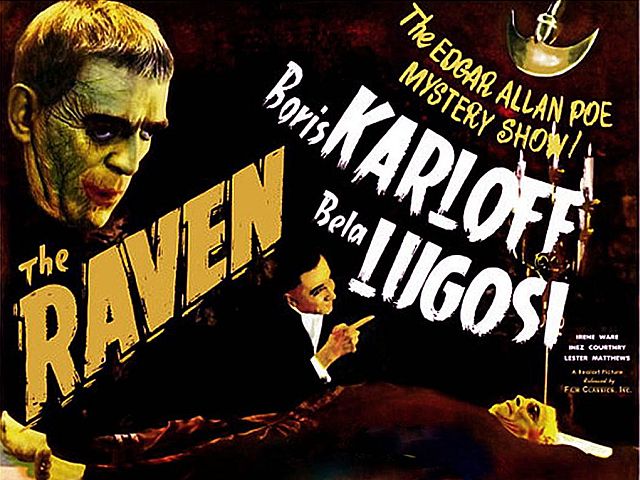
This time, Lugosi plays Dr. Vollin, a brilliant surgeon who has retired to devote himself to the study of pain, torture, and death. In this pursuit, he has built several torture devices in his basement, all of them based on Poe’s stories. While the outside world knows nothing of his torture dungeon, his obsession with the history of torture gets him no strange looks from his friends and former colleagues. But when Vollin returns to the operating room to save the life of beautiful dancer Jean (Irene Ware), he becomes so infatuated with her that his mask of sanity slips to reveal the sadist underneath. At the same time, wanted murderer Bateman (Karloff) comes to Vollin in the hopes that the mad doctor can use plastic surgery to change his appearance. Seeing a chance to use Bateman to carry out a crazed plan to do away with all those who stand between him and Jean, Vollin disfigures him and uses the blackmail of a promise to fix his face in exchange for his handiwork when it comes to violent murder.
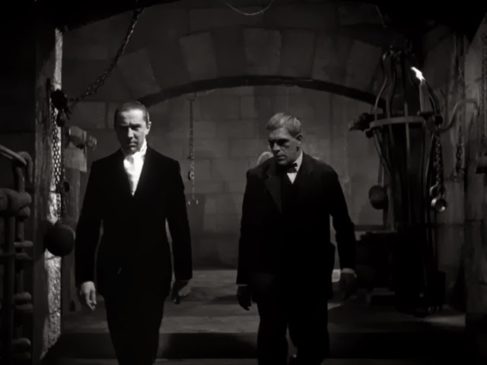
While THE RAVEN is a slight step down from THE BLACK CAT in terms of overall story and filmmaking quality, it is still ludicrous fun with a very macabre sense of humor. Lugosi chews the scenery with his pure villainy, the reveal of Bateman’s disfigured face is given its proper Gothic horror presentation, and director Lew Landers (going by Louis Friedlander) offers up such memorable visuals as a bedroom descending into the basement like an elevator and a room full of mirrors that reflects Bateman’s damaged visage back at him.
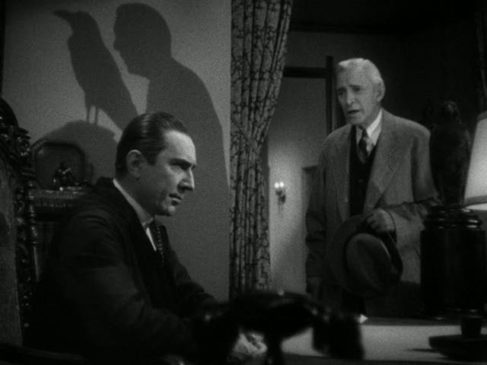
Despite being released a year after THE BLACK CAT, THE RAVEN does feel slightly as though the Hays Code is holding it back quite a bit more. The violence and obvious sexuality is toned down and Vollin’s eventual demise occurs in a disappointingly anti-cinematic way when that pit and the pendulum device was right there for the using. That said, Bateman’s description of burning off a man’s face with an acetylene torch is shockingly graphic for the time and is downright chilling as intoned by Karloff.
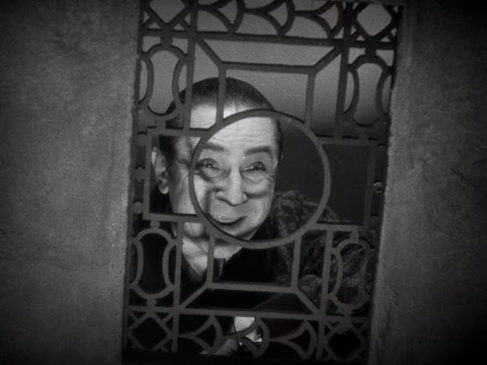
The third film in the set—1936’s THE INVISIBLE RAY—is the weakest of the four, but that does not mean it is a bad film. But compared to the other films here, it is the silliest and most messily plotted, requiring a ton of exposition and too many characters to get it up and running.
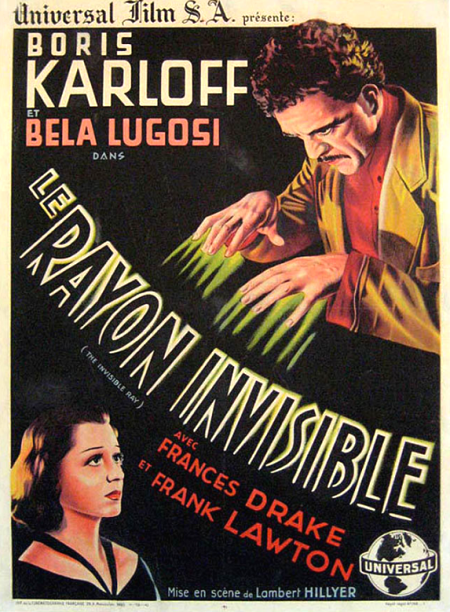
All you really need to know about THE INVISIBLE RAY is that mad Dr. Rukh (Karloff, giving off young Dean Stockwell vibes with his curly hair and spooky/spacey intensity) discovers a new element (after nearly thirty minutes and action that covers two continents) called Radium X. Poisoned by Radium X (it causes him to glow in the dark and instantly kill anything he touches), he turns to rival turned frenemy Dr. Benet (Lugosi) who comes up with a temporary treatment that Rukh needs to inject every day to keep the poison from becoming so great that it not only causes him to kill others, but eventually himself as well. But when Benet harnesses the power of Radium X to heal people of once incurable conditions and is hailed as a hero by the world, Rukh’s jealousy causes him to go mad and he sets out to take his vengeance on everyone he believes has wronged him.
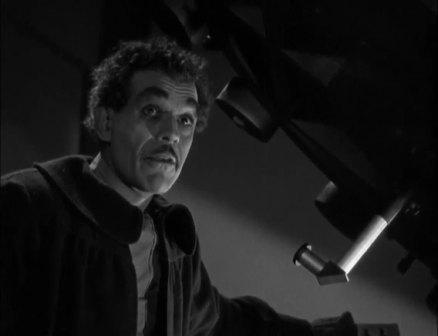
THE INVISIBLE RAY eventually becomes a reasonably diverting mad doctor tale in the third act that is buoyed by Karloff’s demented turn and a couple of haunting images of his menace causing him to literally glow. It also has the benefit of Lugosi playing slightly against type as a mostly sympathetic character (although there seems to be a largely abandoned subplot that portrays Benet as having some barely veiled racist/colonialist tendencies during the scenes set in Africa), upending the usual dynamic with Karloff of two madmen squaring off. But despite a pretty nifty ending, the film is still possibly the shakiest the two stars ever made together.

Easily the oddest film in this set is 1940’s BLACK FRIDAY. While the modernized take on Dr. Jekyll and Mr. Hyde is an obviously plum role for either Karloff or Lugosi to play, neither actor takes on the juicy dual role. Instead, character actor Stanley Ridges gets to chew the scenery as an absent-minded English professor who has part of a gangster’s brain surgically implanted in his skull during a radical, life-saving surgery. With very minimal makeup, Ridges goes back and forth between kindly Professor Kingsley and bloodthirsty killer Red Cannon in what was easily the best performance of his very respectable career.
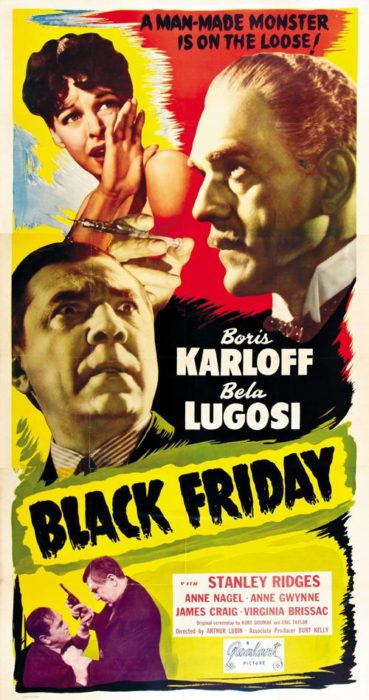
Karloff takes on the supporting role of Dr. Sovac, the possibly mad surgeon who performs the surgery to initially save the life of his friend Kingsley, but then becomes obsessed with using the Red Cannon side of his brain to find the gangster’s money. Lugosi is reduced to a glorified cameo as Cannon’s former partner-in-crime who double-crossed him and is just as eager to get his hands on the seemingly late killer’s money. While both actors do predictably good work, neither turns in anything truly special with their under-written roles, allowing Ridges to shine as the star of the film (even though he gets third billing).

Despite Karloff and Lugosi taking a backseat, BLACK FRIDAY is a real kick. Sure, it lacks the instant sort of fun that comes from watching the two terror titans square off (Karloff and Lugosi never even share a scene together), but Ridges’ unhinged turn, the goofy plot twists, and the brutal (for the time) murders as Red takes his revenge on his former gang make this blending of horror and gangster melodrama a satisfying genre blend.
Each film has been given impressive transfers that are honestly stunning when you consider these films run from nearly eighty to ninety years old. THE BLACK CAT, in particular, looks amazing, but the rest of the films in this set have all been given visual presentations that highlight the painstaking craft that went into stretching the tight budgets to make the movies look more lavish than they actually were.
Of the special features, an excellent four-part documentary called A Good Game: Karloff and Lugosi at Universal that covers the stars’ intertwined careers is the highlight. Contrasting the relatively uninterrupted success that Karloff had from FRANKENSTEIN well into the ’60s with Lugosi’s well-known ups and downs, it is hard not to feel sympathy for the latter. Interestingly, this documentary largely does away with the long-held rumor that Lugosi hated Karloff, resenting his success. Instead, it presents a fairly cohesive working relationship between the two that was built on professionalism and respect (both were founding members of the Screen Actors’ Guild) with occasional frustrations on Lugosi’s part that he didn’t get the same sorts of opportunities as Karloff.
Various fun little extras like an audio recording of Lugosi reading Poe’s The Tell-Tale Heart and a look at some of the films based on Poe’s works are sprinkled throughout the set. There are a wealth of informative commentaries for each movie by film historians like Gregory William Mank, Steve Haberman, Constantine Nasr, and Gary Rhodes, but Tom Weaver’s commentary for THE INVISIBLE RAY stands out for just how irreverent he gets at times. It’s easy to forget that these films were meant to be pure entertainment when looking at them now as strictly historical artifacts, so it’s a nice reminder by Weaver that it’s okay to have fun with them.
But even if this set lacked extras and the sometimes fascinating context given to them by the commentaries, simply having them look as stunning as they do makes this set worth the price of purchase.

The Universal Horror Collection: Volume One is now available from Scream Factory.
Tags: Bela Lugosi, Black Friday, Blu-ray, boris karloff, Constantine Nasr, David Manners, Edgar Allan Poe, Edgar G. Ulmer, Gary Rhodes, Gregory William Mank, Horror Movies, Irene Ware, Julie Bishop, Lew Landers, Louis Friedlander, scream factory, Stanley Ridges, Steve Haberman, The Black Cat, The Hays Code, The Invisible Ray, The Raven, Tom Weaver, Universal Horror

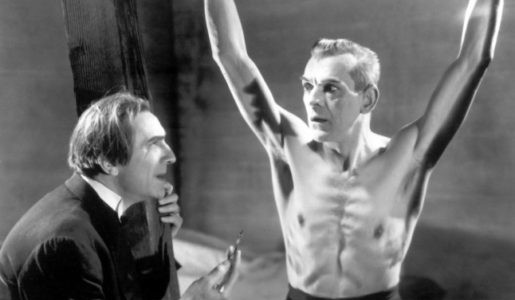
No Comments